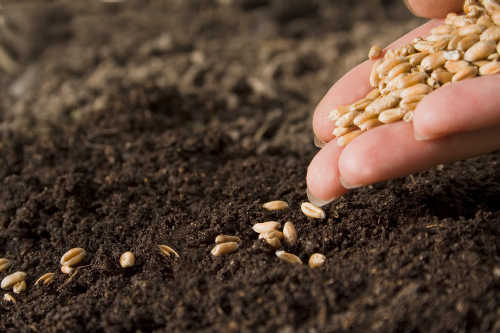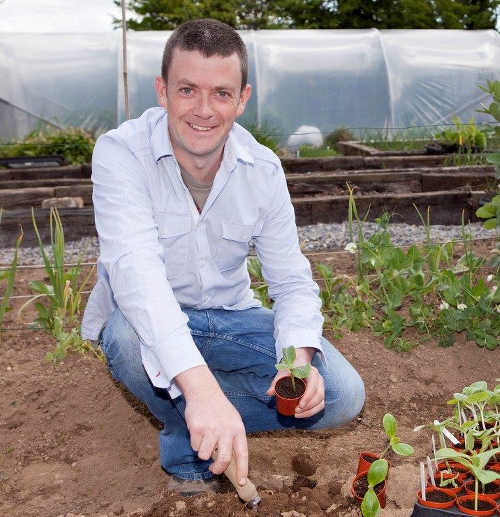Grow It Yourself - June
 Could soil be the new Prozac? This is a question prompted by a recent research study, which found that treatment with a specific soil bacterium, Mycobacterium vaccae, can alleviate the symptoms of depression.
Could soil be the new Prozac? This is a question prompted by a recent research study, which found that treatment with a specific soil bacterium, Mycobacterium vaccae, can alleviate the symptoms of depression.
Scientists set up an experiment whereby mice were put in a beaker of water and watched to see how long they would keep swimming and looking for an exit before giving up. The mice that were treated with the bacteria kept swimming for longer than the control mice, leading the scientists to conclude that they had a more active “coping mechanism”.
A related study by the Sage Colleges in New York, found that soil bacteria can also accelerate learning. More long-suffering mice were fed Mycobacterium vaccae and were subsequently able to navigate a maze twice as fast as the control mice. In yet another study, scientists found that human cancer patients who were injected with Mycobacterium vaccae reported better quality of life and less nausea and pain.
So, how does it work? The researchers believe that the key to it is the ‘happy chemical’ serotonin, which is produced in the brain and acts as a natural anti-depressant. The Mycobacterium vaccae bacteria cause an immune system response in the body, causing serotonin-releasing neurons to fire in the pre-frontal cortex of the brain - the part of our brain known to be involved in mood regulation.
The benefits of regular contact with soil extend beyond mood improvement – it can also improve our immune system function. In 2012, researchers at Harvard Medical School published a study showing the health benefits of contact with soil.
They studied two groups of mice - one that had been exposed to microbes and one that had been raised in germ-free environments – they found that the group with early-life microbe exposure had a better chance at avoiding asthma and inflammatory bowel diseases later in life.
We live in a ‘germaphobic’ society where everything is kept spotlessly clean and germs are considered the enemy. We use antibacterial soaps each time we wash our hands and blitz surfaces with antibacterial wipes.
Vegetables are cleaned before being put on the supermarket shelves, in case we might consider them too dirty to buy. Undoubtedly, improved hygiene has reduced disease in the last century, but have we gone too far?
The research on Mycobacterium vaccae shows that not only is contact with soil good for your immune system function, it will most likely improve your mood too. It’s no wonder GIYers are such a happy bunch – it turns out we’re all jacked up on Mycobacterium vaccae!
Things to do this Month - June
To-Do
Watering and weeding duties step up a notch – the tunnel/greenhouse in particular will require a good deal of water from now on. Watch the weather and water outside as required. Continue to earth-up potato plants to prevent the spuds becoming green. Mulch and water tomato plants and continue to remove side shoots that appear in the leaf axils. Stake everything that grows tall – raspberries, peas, beans, tomatoes etc. Net soft fruit against birds – it’s worth the effort.
Sow
Sow courgettes, pumpkins, summer and winter squash, fennel, chicory. Succession sow: beans (French and Runner), kale, pea, spinach, spinach beet, summer broccoli, carrot, swede, leek, lettuce, Brussels sprouts, beetroot, chicory, endive, turnip, kohlrabi, fennel. Plant out leeks, Brussels Sprouts, cabbage, autumn cauliflower, calabrese, sprouting broccoli, celery, celeriac, cucumbers, pumpkin, marrows, runner beans, aubergine.
Harvest
We are now really starting to see some payback from our GIYing - the first broad beans and peas as well as new potatoes, new carrots, soft fruit like gooseberries, cherries and strawberries. Herbs are in full flow. Also harvest kohlrabi, cabbage, cauliflower (month end), spinach, spring onion, shallots, salad leaves, elderflower, rhubarb, salad leaves, onions, carrots, beetroot, garlic, sea-kale.
Recipe of the Month – Fresh Pea, Courgette and Parmesan Rosti with Tangy Tomato Dressing
I love this Ainsley Harriott summery recipe that celebrates the first of the new season’s courgettes and peas with a brilliant twist on the classic potato rosti.
Ingredients
For the rosti:
• 200g shelled fresh peas
• 350g courgettes, grated
• 150g ground rice
• 3 tbsp shredded basil leaves, plus extra to serve
• 70g parmesan, grated
• 50g pine nuts, lightly toasted
• 2 free-range eggs, lightly beaten
• sea salt and freshly ground black pepper
• 2 tbsp olive oil
For the tangy tomato dressing
• 6 tbsp olive oil
• 1 ripe plum tomato, seeds removed and finely diced
• 4 sun-dried tomatoes in oil, drained and finely chopped
• 1 small shallot, finely chopped
• 1 tbsp red wine vinegar
Directions
For the rosti, blanch the peas in a pan of boiling salted water for two minutes or until just tender then drain well. Refresh in a bowl of iced water and drain again.
Squeeze the courgettes in a clean tea towel and place in a large bowl. Mix in the blanched peas, ground rice, basil, parmesan and pine nuts then add the beaten eggs and season with sea salt and freshly ground black pepper.
Divide the mixture into 16 evenly sized balls and slightly flatten each one. Heat one tablespoon of the olive oil in a large non-stick frying pan over a medium heat and fry half the rosti for 2-3 minutes on each side or until crisp and golden-brown.
Drain on kitchen paper and keep warm. Repeat with the remaining oil and rostis. To make the dressing, place the ingredients in a bowl, mix until well combined and season with sea salt and freshly ground black pepper.
Place a stack of rosti on each plate, drizzle a little dressing over and around the rosti and garnish with a sprinkling of shredded basil leaves.
Tip of the Month – Harvesting Garlic
Knowing when to lift garlic can be a tricky proposition - harvest them too early and the bulbs will be too small, but harvest too late and the bulbs will begin to lose their quality. The old rule is to sow garlic before the shortest day of the year (Dec 21st) and harvest before the longest (June 21st). Some people also do a spring sowing which wont be ready until late July or August.
A good general rule of thumb is to do a test when a third of the leaves on each plant are gone brown. Carefully push back the soil around one plant and have a look at the bulb to check its size. If its too small, put the soil back around it. Lift all your garlic when a half to two-thirds of the leaves are gone brown.
 About GIY
About GIY
GIY is a not-for-profit organisation that aims to create a healthier, more sustainable world where people grow their own food. We inspire and support people to grow food more successfully by bringing them together to share advice, tips and ideas. There are approximately 50,000 people involved in the GIY movement in Ireland, which is proudly supported by Woodies DIY.
For more information check out www.giyireland.com
Michael Kelly is a freelance journalist, author and founder of GIY Ireland.
© GIY Ireland 2014 – all rights reserved.





There are currently no comments
Leave a comment
Not a member? Register for your free membership now!
Or leave a comment by logging in with: